Haug 的半导体光学书65页
直接说:半导体中能带的电子不是纯态,而是处于混合态。必须用密度矩阵描述。
金老师高量讲义中密度矩阵
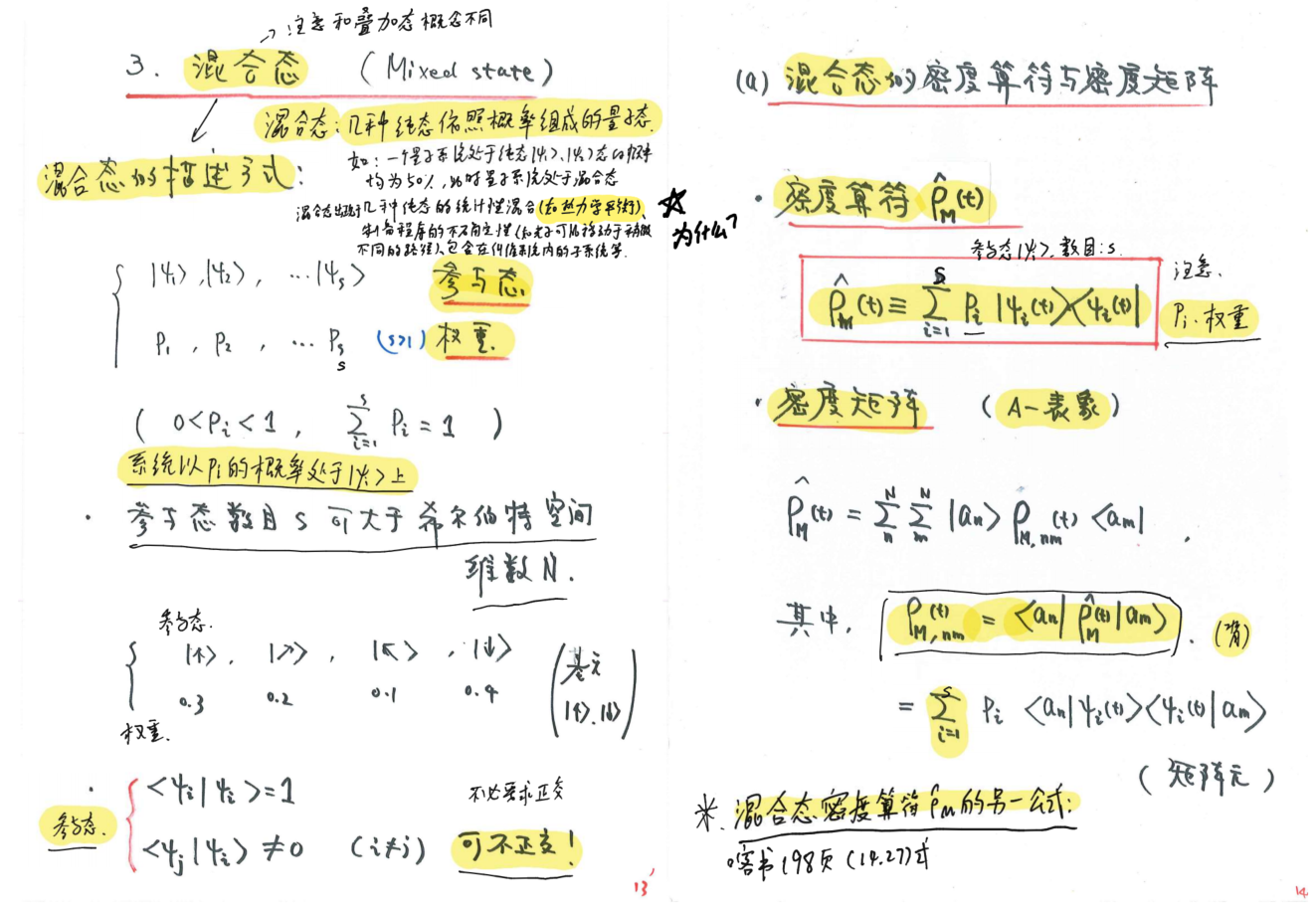
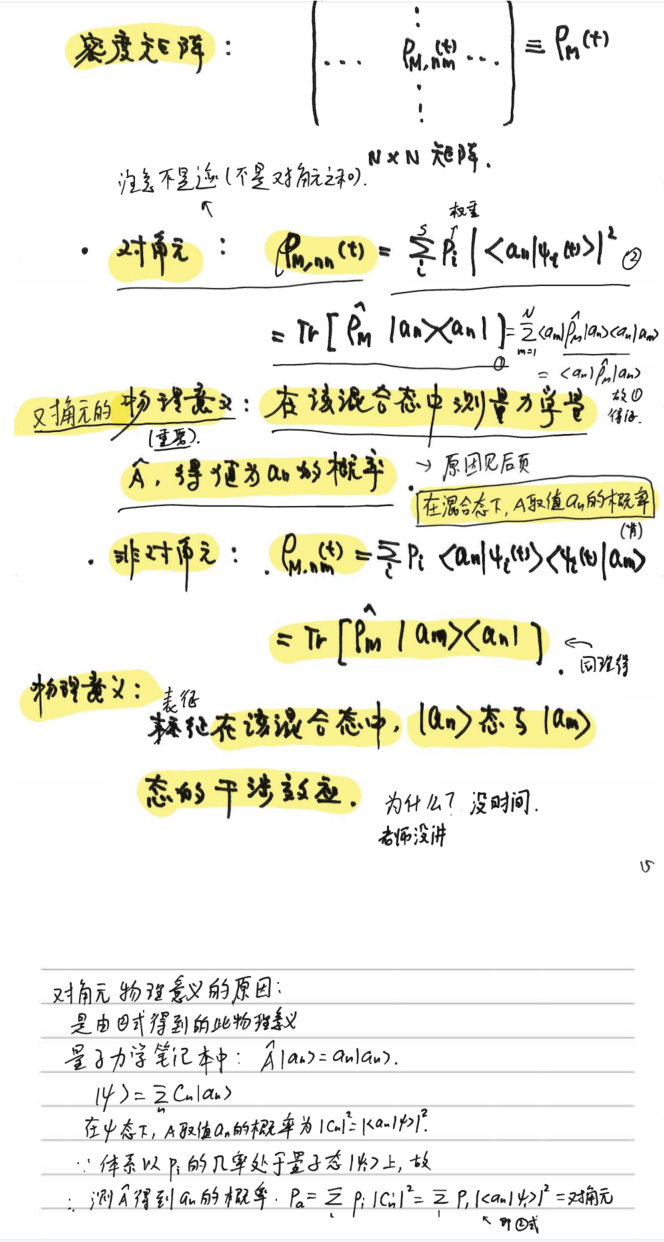
混合态平均值公式\(\operatorname{Tr}\left[\hat{\rho}_{M} \hat{B}\right]\)的含义: 在混合态中,既计算了量子力学平均,也计算了统计平均
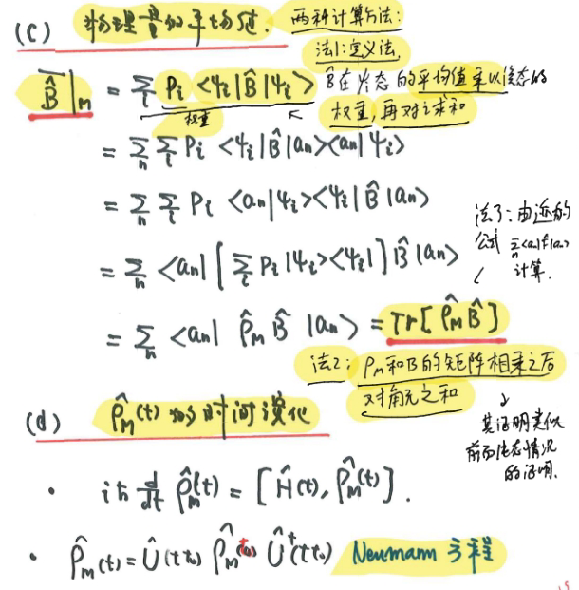 但这里的前提是:****是完备集。(特别重要,必须满足此前提,\(\operatorname{Tr}\left[\hat{\rho}_{M} \hat{B}\right]\)才成立)
但这里的前提是:****是完备集。(特别重要,必须满足此前提,\(\operatorname{Tr}\left[\hat{\rho}_{M} \hat{B}\right]\)才成立)
特别注意,根据混合态的物理意义:必须用混合态的语言来描述系统的宏观状态(系统的宏观状态就是一个混合态)[1]知:在混合态中这样计算的平均值 是:既计算了量子力学平均,也计算了统计平均(即系综平均,因为正则系综就是混合态)。
为知笔记中密度矩阵的相关笔记内容:
纯态和混合态的区别:纯态就是系统处于\(\psi_1\)和\(\psi_2\)的叠加态这样一个新态。混合态是系统一定概率可能处于\(\psi_1\)或\(\psi_2\)
喀书:纯态就是系统处于和的叠加态这样一个新态。混合态是系统一定概率可能处于或。
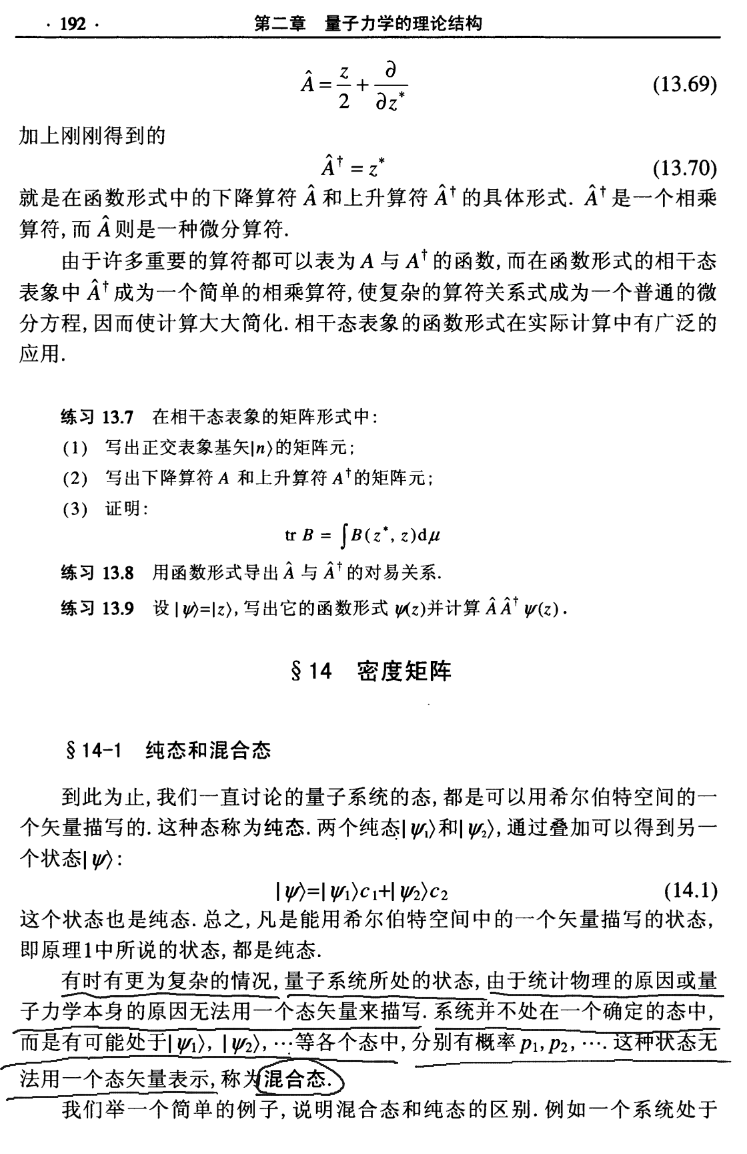


混合态的物理意义:必须用混合态的语言来描述系统的宏观状态(系统的宏观状态就是一个混合态)
先复习统计物理笔记本中关于系综、正则系综:关于林书的笔记:
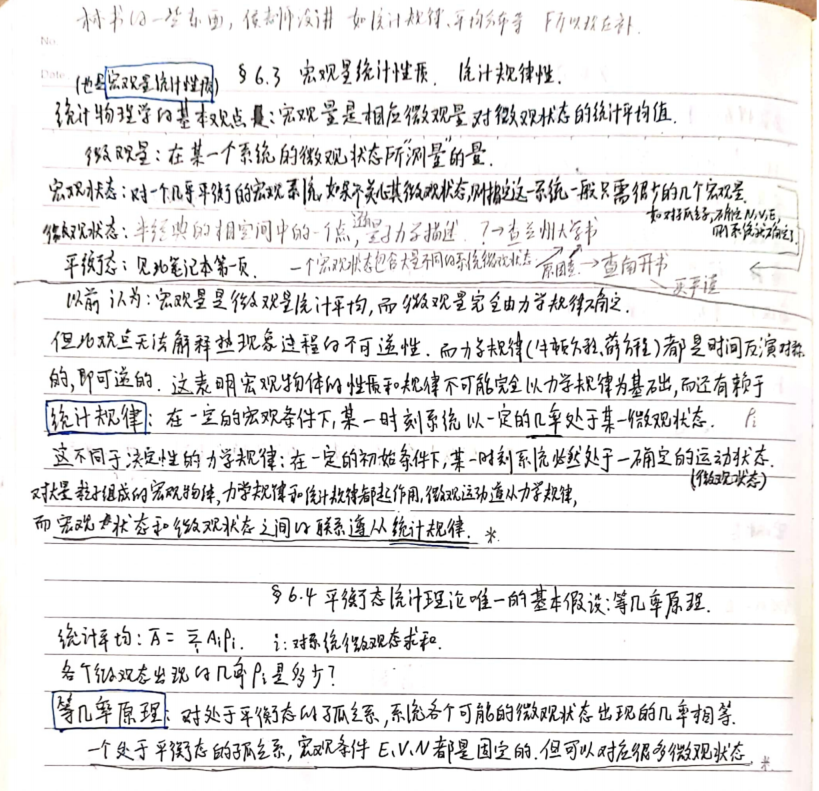


在热统笔记本关于林书的笔记非常重要,系统的微观状态不同于系统的宏观状态。力学规律确定了系统的微观状态,但不能确定宏观状态,还需要统计规律。所以,一个波函数****能描述系统的微观状态,但不能描述系统的宏观状态,必须用混合态的语言来描述系统的宏观状态。这也就是混合态的意义!(这也是量子力学平均后还需要统计平均(在Haug的半导体光学书90页称之为系综平均)的原因)
系统的宏观状态就是一个混合态! 系统的微观状态作为参与态。
热统林书很重要,可以复习林书从178页开始。
量子统计、正则系综中密度算符的应用
金老师讲义:高量+
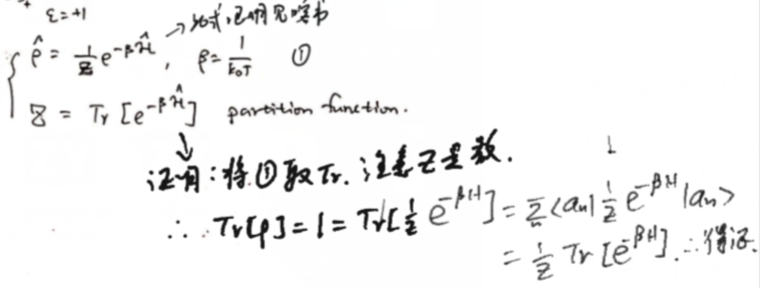
喀书:
正则系综是混合态!(其实系综就是混合态)
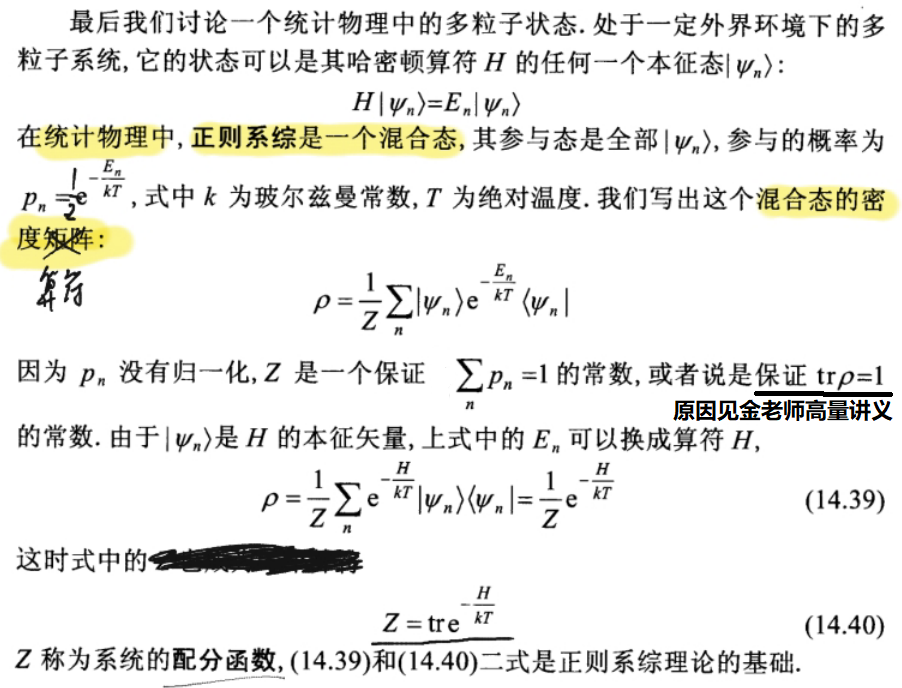 (注意这是多粒子密度算符,不是k态单粒子密度算符)
(注意这是多粒子密度算符,不是k态单粒子密度算符)
系综:具有相同的力学性质,在相同宏观条件下,大量系统构成的集合。见本科统计物理笔记本
曾书卷二20页:
例 6 与大热源达到平衡,温度为 \(T\) 的体系(正则系综),处于非纯态(即混合态),用密席算符
描述, \(\beta=1 / k T, k\) 为 Boltzmann 常量,H 为 Hamilton 算符, \(Z=\operatorname{tr}\left(\mathrm{e}^{-\beta H}\right)\) 称为配分函数(partition function). 在能量表象中(基矢 \(\left.|n\rangle, H|n\rangle=E_{n}|n\rangle\right)\), 密度矩阵为
以谐振子为例, \(E_{n}=\left(n+\frac{1}{2}\right) \hbar \omega, n=0,1,2, \cdots\)
谐振子处于 \(E_{n}\) 能级的概率为
所以能量平均值为
可以看出, 当 \(T \rightarrow \infty(\beta \rightarrow 0)\) 时, \(\langle E\rangle \rightarrow \frac{1}{\beta}=k T\), 与经典统计 (Boltzmann 统计)给出的结果相同. 相 反, 在低温极限 \(T \rightarrow 0(\beta \rightarrow \infty)\) 下, \(\langle E\rangle=\hbar \omega / 2\), 即所有谐振子在低温极限下, 都倾向于布居在基 态上.
约化密度算符
见金老师高量讲义:
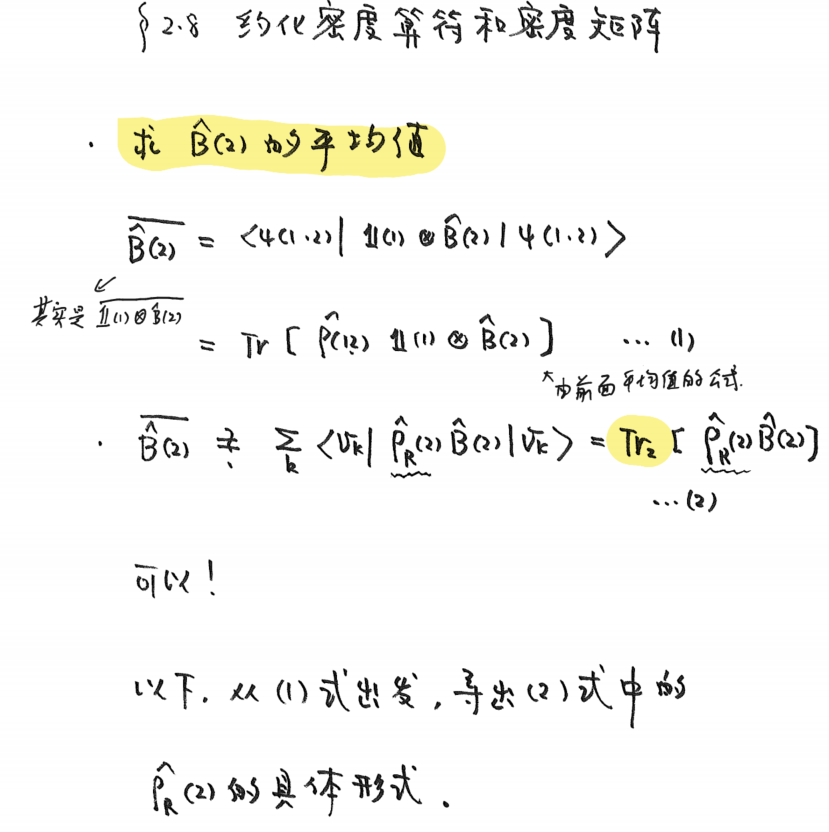
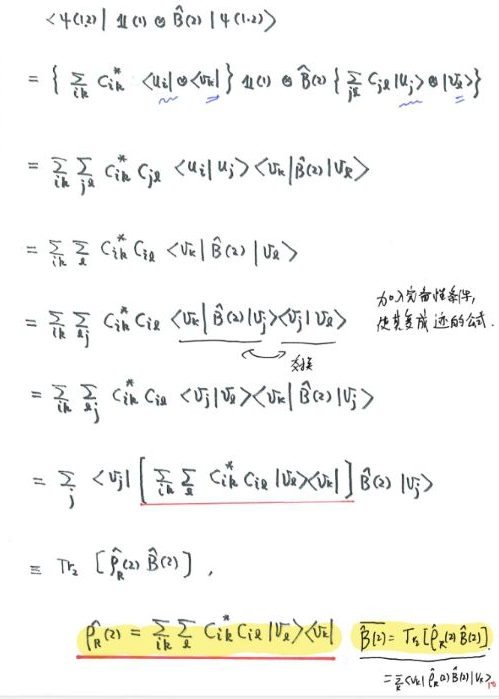

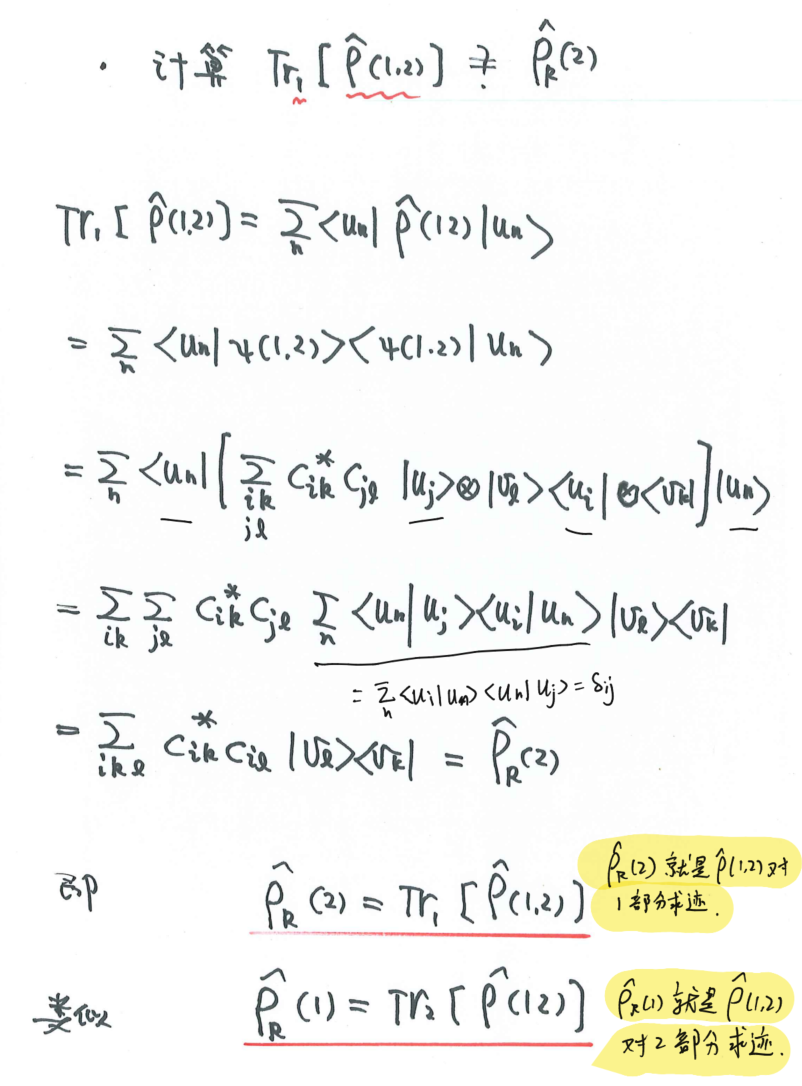
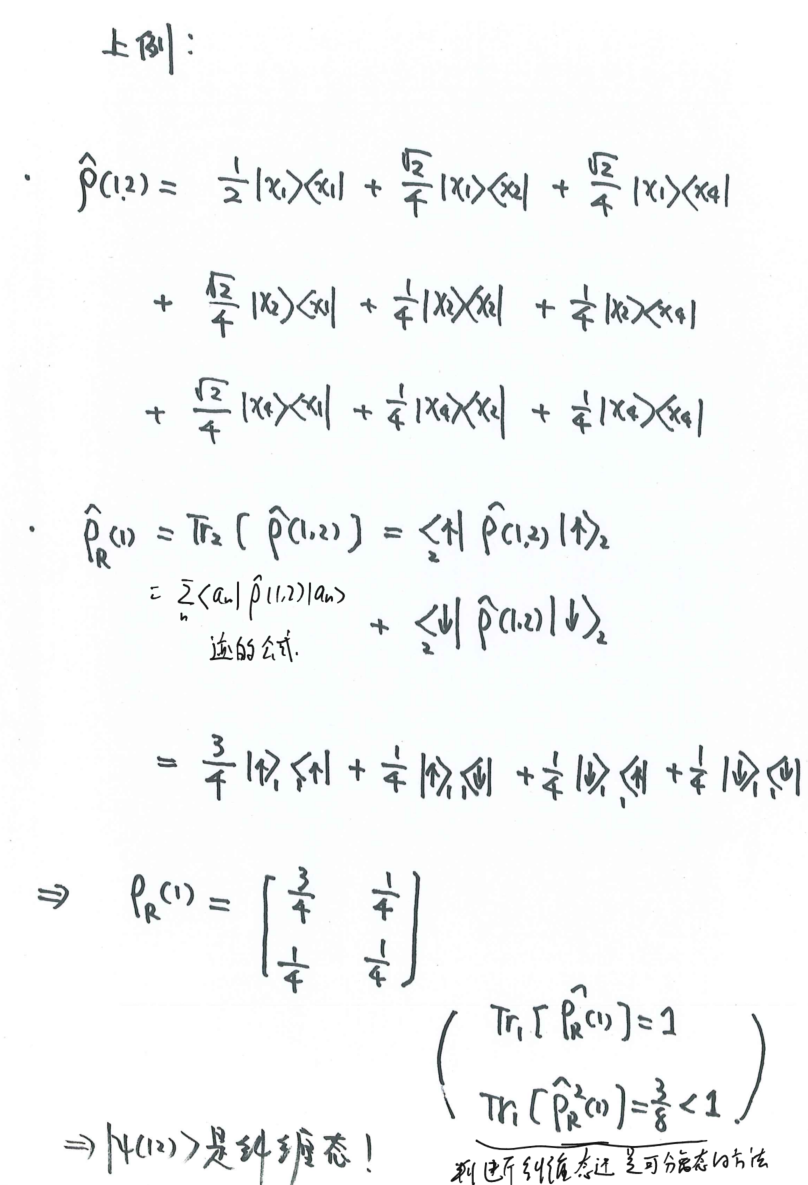
纯态和混合态的实际例子:
Density Matrix (virginia.edu):
Pure States and Mixed States
Our treatment here more or less follows that of Sakurai, beginning with two imagined Stern-Gerlach experiments. In that experiment, a stream of (non-ionized) silver atoms from an oven is directed through an inhomogeneous vertical magnetic field, and the stream splits into two. The silver atoms have nonzero magnetic moments, and a magnetic moment in an inhomogeneous magnetic field experiences a nonzero force, causing the atom to veer from its straight line path, the magnitude of the deflection being proportional to the component of the atom's magnetic moment in the vertical (field) direction. The observation of the beam splitting into two, and no more, means that the vertical component of the magnetic moment, and therefore the associated angular momentum, can only have two different values. From the basic analysis of rotation operators and the properties of angular momentum that follow, this observation forces us to the conclusion that the total angular momentum of a silver atom is \(\frac{1}{2} \hbar\). Ordinary orbital angular momenta cannot have halfinteger values; this experiment was one of the first indications that the electron has a spin degree of freedom, an angular momentum that cannot be interpreted as orbital angular momentum of constituent parts. The silver atom has 47 electrons, 46 of them have total spin and orbital momenta that separately cancel, the \(47^{\text {th }}\) has no orbital angular momentum, and its spin is the entire angular momentum of the atom.
Here we shall use the Stern-Gerlach stream as an example of a large collection of quantum systems (the atoms) to clarify just how to describe such a collection, often called an ensemble. To avoid unnecessary complications, we only consider the spin degrees of freedom. We begin by examining two different streams:
Suppose experimentalist \(A\) prepares a stream of silver atoms such that each atom is in the spin state \(\psi_{A}\) :
Meanwhile, experimentalist \(B\) prepares a stream of silver atoms which is a mixture: half the atoms are in state \(|\uparrow\rangle\) and half are in the state \(|\downarrow\rangle\) : call this mix \(B\).
Question: can we distinguish the \(A\) stream from the \(B\) stream?
Evidently, not by measuring the spin in the \(z\)-direction! Both will give up \(50 \%\) of the time, down \(50 \%\).
But: we can distinguish them by measuring the spin in the \(x\)-direction: the \(\psi_{A}\) quantum state is in fact just that of a spin in the \(x\)-direction, so it will give "up" in the \(x\)-direction every time-from now on we call it \(\left|\uparrow_{x}\right\rangle\), whereas the state \(|\uparrow\rangle\) ("up" in the \(z\)-direction) will yield "up" in the \(x\)-direction only \(50 \%\) of the time, as will \(|\downarrow\rangle\).
The state \(\psi_{A}=\left|\uparrow_{x}\right\rangle\) is called a pure state, it's the kind of quantum state we've been studying this whole course.
The stream \(B\), in contrast, is in a mixed state: the kind that actually occurs to a greater or lesser extent in a real life stream of atoms, different pure quantum states occurring with different probabilities, but with no phase coherence between them. In other words, these relative probabilities in \(B\) of different quantum states do not derive from probability amplitudes, as they do in finding the probability of spin up in stream \(A\) : the probabilities of the different quantum states in the mixed state \(B\) are exactly like classical probabilities.
That being said, though, to find the probability of measuring spin up in some such mixed state, one first uses the classical-type probability for each component state, then for each quantum state in the mix, one finds the probability of spin up in that state by the standard quantum technique.
Therefore, for a mixed state in which the system is in state \(\left|\psi_{i}\right\rangle\) with probability \(w_{i}, \sum w_{i}=1\), the expectation value of an operator \(\widehat{A}\) is
and we should emphasize that these \(\left|\psi_{i}\right\rangle\) do not need to be orthogonal (but they are of course normalized): for example one could be \(\left|\uparrow_{x}\right\rangle\), another \(\left|\uparrow_{z}\right\rangle\). (We put the usually omitted \(z\) in for emphasis.) The reason we put a hat on \(\widehat{A}\) here is to emphasize that this is an operator, but the \(w_{i}\) are just numbers.
量子退相干
量子退相干到底是什么意思? - 知乎 (zhihu.com):
量子退相干到底是什么意思? - 也疏寒的回答 - 知乎
https://www.zhihu.com/question/313273016/answer/633965523 :
量子退相干指的是一个量子态在环境噪声的影响下变成一个非相干态。要回答什么叫量子退相干,
对于一个量子态 \(|\Psi\rangle=\alpha|0\rangle+\beta|1\rangle\) ,我们称他处于 \(|0\rangle\) 和 \(|1\rangle\) 的相干菷加态上,也就是 我们能以 \(|\alpha|^{2}\) 的概率观测到粒子处于 \(|0\rangle\) ,以 \(|\beta|^{2}\) 的概率观测到粒子处于 \(|1\rangle\) 。比如一个自旋 系统,我们有可能测得它处于上旋态,也有可能测得它处于下旋态。但这并不是相干喗加的全部,
因为经典体系我们也能做到这一点,比如经典统计物理中粒子就是以一定的概率处于各个微观态上 的,比如能以 \(|\alpha|^{2}\) 的概率观测到粒子处于 \(|0\rangle\) ,以 \(|\beta|^{2}\) 的概率观测到粒子处于 \(|1\rangle\) 。那怎么区 别这经典概率混合和量子相干呢。最好的办法就是通过密度矩阵来看。任何一个量子态都可以写成 密度矩阵的形式 \(\rho=|\Psi\rangle\langle\Psi|\) ,这是一个Hermitian的半正定算子,并且迹为 1 。用密度矩阵表 示态是朗道大帝引入的,他能表示的量子态更多。普通的量子态叫做纯态,而不能写成某个波函数 对应的密度矩阵的态 \(\rho=|\Psi\rangle\langle\Psi|\) 叫做混态,如 \(\rho=p_{0}|0\rangle\left\langle 0\left|+p_{1}\right| 1\right\rangle\langle 1|\) 其中 \(p_{0} \neq 0,1\) 。区别纯态和混合态的方法就是求迹,如果 \({Tr}\left(\rho^{2}\right)=1\) 就是纯态,如果 \(\operatorname{Tr}\left(\rho^{2}\right)<1\) 。说了这么多关于密席矩阵的东西,下面我们要给出一个严格的量子相干的现代定 义 \(_{0}\)
在给定的一组测量基 \(|0\rangle, \cdots,|d-1\rangle\) 下面,如果一个密度矩阵 \(\rho\) 的所有非对角元全为零,那 这个态称为非相干态,否则的话,他就称为相干态。这里需要强调的就是相干不相干一定得在选定 的基底下说才有意义。量子态 \(|\Psi\rangle=\alpha|0\rangle+\beta|1\rangle\) 在 \(|0\rangle,|1\rangle\) 基下面是相干的,但是在 \(|\Psi\rangle,\left|\Psi^{\perp}\right\rangle\) 下却是非相干态。
所谓的经典概率混合就是以一定的概率分布混合各个测量基所对应的量子态。上边给出了一个公理 化的定义。下面我给一些直观的说明。拿波函数 \(\Psi(x)\) 来举例。在给定的基底 \(\phi_{1}(x), \cdots, \phi_{n}(x)\) 下
量子相干疍加: \(\Psi(x)=c_{1} \phi_{1}(x)+\cdots+c_{n} \phi_{n}(x)\) ,其中粒子以概率 \(p_{i}=\left|c_{i}\right|^{2}\) 处于 量子态 \(\phi_{i}(x)\) 上;
经典的概率混合: \(p_{1}: \phi_{1}(x), \cdots, p_{n}: \phi_{n}(x)\) ,这时候我们是写不出量子态的形式的,粒 子以 \(p_{i}=\left|c_{i}\right|^{2}\) 的概率处于量子态 \(\phi_{i}(x)\) 上。
但上面两种情况有本质的不同。如果我们想测粒子出现在 \(x\) 处的概率,对于量子租加态我们有
这里有许多交叉项。而经典情形下 \(p(x)=p_{1}\left|\phi_{1}(x)\right|^{2}+\cdots+p_{n}\left|\phi_{n}(x)\right|^{2}\) 。它们有本 质的不同。也就是说经典的概率混合就是没有干涉的混合,而量子螢加就像是波一样具有干涉。
量子退相干就指的是一个相干量子态在外界的影响下变成一个非相干量子态的过程。可以把环境看 成是测量仪器,因为环境无时无刻不在观察我们的物理系统(温度,射线,光照,诸如此类的过 程),这样的话一个相干急加的量子态,比如 \(\Psi(x)=c_{1} \phi_{1}(x)+\cdots+c_{n} \phi_{n}(x)\) ,最后 会变成一个经典的概率混合: \(p_{1}: \phi_{1}(x), \cdots, p_{n}: \phi_{n}(x)\) 。量子系统的脆弱性就指的是相 干胥加的脆弱性 (有时候还指约缠的脆弱性)。
我顺带也给一下量子退相干的形式化表述吧。一个量子操作 (包括量子贬量和量子信道) 指的是把 一个密度矩阵变成另一个密度矩阵的变换,一般记为 \(\mathcal{E}(\rho)\) ,因为这种变换是把一个矩阵变成一个 矩阵,所以它对应的是针对量子态的酉变换。如果一个矩阵之间的变换满足保迹(tracepreserving) 并且complete-positive,他就是一个量子操作。在给定的一组测量基 \(|0\rangle, \cdots,|d-1\rangle\) 下面,如果 \(\rho\) 是一个相干态,量子操作 \(\mathcal{E}\) 称为 \(\rho\) 的一个退相干过程当且仅 当 \(\mathcal{E}(\rho)\) 在给定的测量基 \(|0\rangle, \cdots,|d-1\rangle\) 下面是非相干态 (非对角元全为零)。
混合态的物理意义:必须用混合态的语言来描述系统的宏观状态(系统的宏观状态就是一个混合态)
↩︎